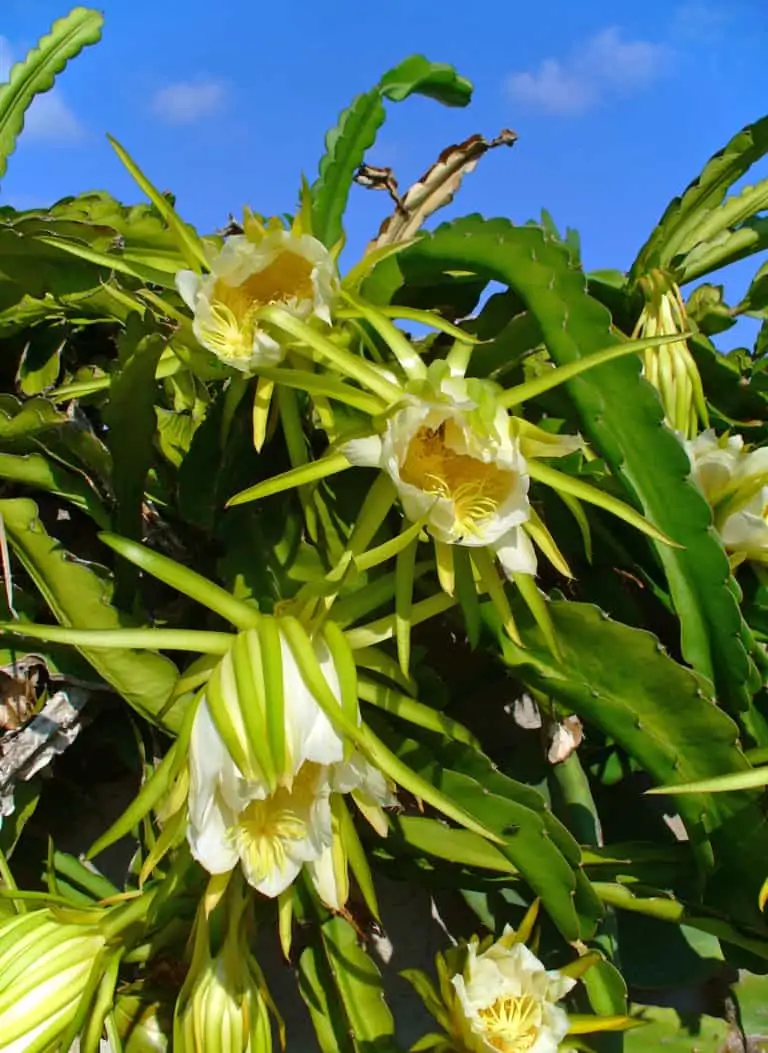Hylocereus undatus seeds
Accepted Scientific Name:
Hylocereus undatus
Synonyms:
Selenicereus undatus, Cereus undatus
Common Names:
White Dragon Fruit Pitahaya Night-Blooming Cereus Strawberry Pear
Plant Origin:
Hylocereus undatus – White-Fleshed Dragon Fruit Cactus
Hylocereus undatus, more commonly known as White Dragon Fruit, Pitahaya, or Strawberry Pear, is a striking climbing cactus prized for its ornamental beauty and delicious tropical fruit. Native to Central America and the Caribbean, this species has been widely cultivated in tropical and subtropical regions across the globe—including Southeast Asia, Australia, and the southern United States. Its fast-growing nature, exotic appeal, and high nutritional value make it a favorite among gardeners, collectors, and commercial growers alike.
This cactus is known for its three-sided, fleshy stems that can grow several feet long in a single season. These stems are bright to medium green, ribbed, and edged with small areoles that bear short, harmless spines. As an epiphytic cactus, Hylocereus undatus naturally climbs and drapes itself over rocks, trees, or trellises, giving it a dramatic, trailing form. In cultivation, it is often trained vertically on posts or trellises to maximize space and encourage strong upright growth, especially for fruit production.
One of the most enchanting features of Hylocereus undatus is its enormous night-blooming flowers. These flowers are pure white, highly fragrant, and can measure up to 12 inches across. They bloom for just a single evening and into the early morning hours, often coinciding with full moons or periods of high humidity. In the wild, these blooms are pollinated by bats and moths, although in cultivation, hand pollination or the presence of pollinators can greatly enhance fruit set. Even if they bloom infrequently, their appearance is always a spectacle and a highlight for any grower.
When pollination is successful, these blooms develop into large, oval fruits with a vibrant pink outer skin and contrasting white flesh speckled with tiny black seeds. The fruit is both beautiful and nutritious, offering a mildly sweet, refreshing flavor reminiscent of kiwi or pear. Dragon fruit is high in vitamin C, antioxidants, magnesium, and dietary fiber, making it not just a tasty treat but a healthy one as well. It’s often eaten fresh, blended into smoothies, turned into sorbet, or added to fruit salads.
Hylocereus undatus thrives in full sun to partial shade, depending on the intensity of the local climate. In desert environments, some afternoon shade is beneficial, while in more temperate regions, full sun promotes vigorous growth and better fruiting. It grows best in well-draining soil with moderate organic content—cactus mix amended with compost works well. The plant requires regular watering during its growing season (spring through fall), but like most cacti, it should be allowed to dry out between waterings. Overwatering or poorly draining soil can lead to root rot.
This species is hardy in USDA Zones 10–11, where it can be grown outdoors year-round. In cooler climates, it can be grown in containers and moved indoors during the winter months. Indoors, it should be placed near a bright south- or west-facing window or grown under supplemental lighting. While it may not fruit indoors without optimal conditions, it can still be enjoyed as a unique and attractive houseplant.
Key Benefits and Features
-
Produces large, edible dragon fruit with white flesh and black seeds
-
Climbing cactus with dramatic, sprawling stems
-
Night-blooming flowers that are fragrant and enormous
-
Attracts pollinators, including bats, bees, and moths
-
Perfect for trellises, arbors, and vertical gardening
-
Ideal for containers in non-tropical zones
-
High in nutrients, including vitamin C and fiber
-
Fast-growing, making it excellent for quick coverage or harvest
Growing Tips
-
Provide strong support such as a wooden post, concrete pillar, or trellis
-
Use well-draining soil; avoid clay or heavy garden soils
-
Water deeply but infrequently—allow soil to dry between waterings
-
Protect from frost; temperatures below 32°F can damage or kill the plant
-
Fertilize during the active growing season with a balanced fertilizer
-
For fruit, ensure pollination either naturally or by hand
Whether you are an exotic fruit enthusiast, a cactus lover, or someone looking to add a bold statement to your edible landscape, Hylocereus undatus offers exceptional beauty, performance, and reward. Its dramatic presence, nighttime blooms, and delicious fruit make it a conversation piece as much as a garden treasure.
